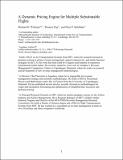A dynamic pricing engine for multiple substitutable flights
Author(s)
Wittman, Michael D.; Fiig, Thomas; Belobaba, Peter P
Download41272_2018_149_ReferencePDF.pdf (1.600Mb)
Publisher Policy
Publisher Policy
Article is made available in accordance with the publisher's policy and may be subject to US copyright law. Please refer to the publisher's site for terms of use.
Terms of use
Metadata
Show full item recordAbstract
As enhancements in airline IT begin to expand pricing and revenue management (RM) capabilities, airlines are starting to develop dynamic pricing engines (DPEs) to dynamically adjust the fares that would normally be offered by existing pricing and RM systems. In past work, simulations have found that DPEs can lead to revenue gains for airlines over traditional pricing and RM. However, these algorithms typically price each itinerary independently without directly considering the attributes and availability of other alternatives. In this paper, we introduce a dynamic pricing engine that simultaneously prices multiple substitutable itineraries that depart at different times. Using a Hotelling line (also called a locational choice model) to represent customer tradeoffs between departure times and price, the DPE dynamically suggests increments or decrements to the prices of pre-determined fare products as a function of booking request characteristics, departure time preferences, and the airline’s estimates of customer willingness-to-pay. Simulations in the Passenger Origin–Destination Simulator (PODS) show that simultaneous dynamic pricing can result in revenue gains of between 5 and 7% over traditional RM when used in a simple network with one airline and two flights. The heuristic produces revenue gains by stimulating new bookings, encouraging business passenger buy-up, and leading to spiral-up of forecast demand. However, simultaneous dynamic pricing produces marginal gains of less than 1% over a DPE that prices each itinerary independently. Given the complexity of specifying and implementing a simultaneous pricing model in practice, practitioners may prefer to use a flight-by-flight approach when developing DPEs.
Date issued
2018-04Department
Massachusetts Institute of Technology. Department of Aeronautics and AstronauticsJournal
Journal of Revenue and Pricing Management
Publisher
Springer Science and Business Media LLC
Citation
Wittman, Michael D. et al. "A dynamic pricing engine for multiple substitutable flights." Journal of Revenue and Pricing Management 17, 6 (April 2018): 420–435 © 2018 Macmillan Publishers Ltd., part of Springer Nature
Version: Author's final manuscript
ISSN
1476-6930
1477-657X